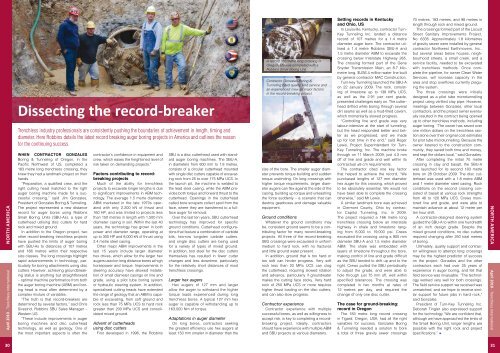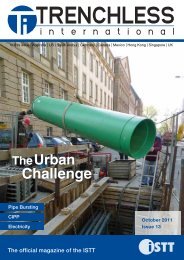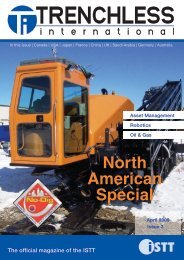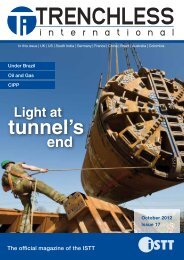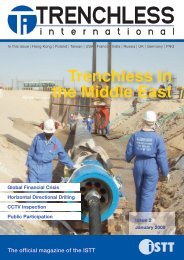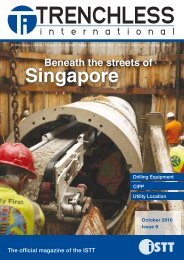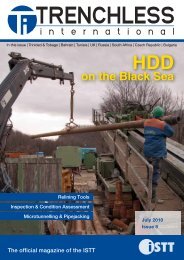Boring - Trenchless International
Boring - Trenchless International
Boring - Trenchless International
You also want an ePaper? Increase the reach of your titles
YUMPU automatically turns print PDFs into web optimized ePapers that Google loves.
North america<br />
April 2010 - <strong>Trenchless</strong> <strong>International</strong><br />
Dissecting the record-breaker<br />
<strong>Trenchless</strong> industry professionals are consistently pushing the boundaries of achievement in length, timing and<br />
diameter. Here Robbins details the latest record breaking auger boring projects in America and outlines the reason<br />
for the continuing success.<br />
When contractor Gonzales<br />
<strong>Boring</strong> & Tunneling of Oregon, in the<br />
Pacific Northwest of US, completed a<br />
183 metre long trenchless crossing, they<br />
knew they had a landmark project on their<br />
hands.<br />
“Preparation, a qualified crew, and the<br />
right cutting head matched to the right<br />
auger boring machine made for a successful<br />
crossing,” said Jim Gonzales,<br />
President of Gonzales <strong>Boring</strong> & Tunneling.<br />
The project represented a new distance<br />
record for auger bores using Robbins<br />
Small <strong>Boring</strong> Units (SBU-As), a type of<br />
cutterhead utilising disc cutters for hard<br />
rock and mixed ground.<br />
In addition to the Oregon project, two<br />
other record-breaking trenchless projects<br />
have pushed the limits of auger boring<br />
with SBU-As to distances of 107 metres<br />
and 166 metres within their respective<br />
size classes. The long crossings highlight<br />
rapid advancements in technology, particularly<br />
for boring attachments using disc<br />
cutters. However, achieving groundbreaking<br />
status is anything but straightforward<br />
– optimal machine performance from both<br />
the auger boring machine (ABM) and boring<br />
head is most often determined by a<br />
complex mixture of variables.<br />
“The truth is that record-breakers are<br />
determined by several factors,” said Chris<br />
Sivesind, Robbins SBU Sales Manager –<br />
Western US.<br />
“These include improvements in auger<br />
boring machines and disc cutterhead<br />
technology, as well as geology. One of<br />
the most important aspects is often the<br />
contractor’s confidence in equipment and<br />
crew, which eases the heightened level of<br />
risk taken on demanding projects.”<br />
Factors contributing to recordbreaking<br />
projects<br />
Much of the ability for trenchless<br />
projects to excavate longer lengths is due<br />
to significant improvements in ABM technology.<br />
The average 1.5 metre diameter<br />
ABM marketed in the late 1970s operated<br />
with only 2,200 kN of thrust and<br />
160 HP, and was limited to projects less<br />
than 150 metres in length with 1,500 mm<br />
diameter casing in soil. Within the last 40<br />
years, the technology has grown in both<br />
power and diameter range, operating at<br />
up to 300 HP and 8,000 kN of thrust using<br />
2.4 metre steel casing.<br />
Other major ABM improvements in the<br />
last 15 years include larger diameter<br />
hex drives, which allow for the larger hex<br />
augers used on long distance bores at high<br />
horsepower and torque. Improvements in<br />
steering accuracy have allowed installation<br />
of small diameter casings on line and<br />
grade, using a pilot tube boring system<br />
or hydraulic steering system. In addition,<br />
specialised cutting heads have extended<br />
the range of geology that an ABM is capable<br />
of excavating, from soft ground and<br />
rock less than 75 MPa UCS to hard rock<br />
greater than 200 MPa UCS and consolidated<br />
mixed ground.<br />
Advent of cutterheads<br />
using disc cutters<br />
First developed in 1996, the Robbins<br />
SBU is a disc cutterhead used with standard<br />
auger boring machines. The SBU-A,<br />
in diameters from 600 mm to 1.8 metres,<br />
consists of a circular cutterhead mounted<br />
with single disc cutters capable of excavating<br />
rock from 25 to over 175 MPa UCS. In<br />
the launch pit, the machine is welded to<br />
the lead steel casing, while the ABM provides<br />
both torque and forward thrust to the<br />
cutterhead. Openings in the cutterhead<br />
called bore scrapers collect spoil from the<br />
face, where they are transferred to a fullface<br />
auger for removal.<br />
Over the last ten years, SBU cutterhead<br />
technology has improved for specific<br />
ground conditions. Cutterhead configurations<br />
that feature a combination of carbide<br />
bits, two-row tungsten carbide cutters,<br />
and single disc cutters are being used<br />
for a variety of types of mixed ground.<br />
In addition, tool steel for the disc cutters<br />
themselves has resulted in fewer cutter<br />
changes and less downtime, particularly<br />
for the relatively short distances of most<br />
trenchless crossings.<br />
Larger hex augers<br />
Hex augers of 127 mm and larger<br />
allow the auger to withstand the higher<br />
torque loads experienced during long<br />
trenchless bores. A typical 127 mm hex<br />
auger is capable of withstanding up to<br />
163,000 Nm of torque.<br />
Adaptations in auger diameter<br />
On long bores, contractors seeking<br />
the greatest efficiency use hex augers at<br />
least 150 mm smaller in diameter than the<br />
A record 183 metre long crossing in<br />
Oregon, US was completed with a<br />
Robbins Small <strong>Boring</strong> Unit.<br />
Contractor Gonzales <strong>Boring</strong> &<br />
Tunneling cited quality field service and<br />
an experienced crew as major factors<br />
in the record-breaking project.<br />
size of the bore. The smaller auger diameter<br />
prevents torque building and sudden<br />
torque unwinding. On long crossings with<br />
higher torque requirements, larger diameter<br />
augers can flex against the side of the<br />
casing, building up torque and unleashing<br />
the force suddenly – a scenario that can<br />
destroy gearboxes and damage valuable<br />
equipment.<br />
Ground conditions<br />
Whatever the ground conditions may<br />
be, consistent ground seems to be a contributing<br />
factor for many record-breaking<br />
projects. All three of the record-breaking<br />
SBU crossings were excavated in uniform<br />
medium to hard rock, with no fractures<br />
and little ground water present.<br />
In addition, ground that is too hard or<br />
too soft can hinder progress. Very soft<br />
rock less than 20 MPa UCS can clog<br />
the cutterhead, requiring slowed rotation<br />
and advance, particularly if groundwater<br />
makes the cutting face sticky. Very hard<br />
rock of 250 MPa UCS or more requires<br />
higher thrust loading on the disc cutters,<br />
and can also slow progress.<br />
Contractor experience<br />
Contractor experience with multiple<br />
successful bores, as well as willingness to<br />
accept risk, is key to completing a recordbreaking<br />
project. Ideally, contractors<br />
should have experience with multiple ABM<br />
and SBU projects at various diameters.<br />
Setting records in Kentucky<br />
and Ohio, US<br />
In Louisville, Kentucky, contractor Turn-<br />
Key Tunneling Inc. landed a distance<br />
record of 107 metres for a 1.4 metre<br />
diameter auger bore. The contractor utilised<br />
a 1.4 metre Robbins SBU-A and<br />
1.5 metre diameter ABM to excavate the<br />
crossing below Interstate Highway 265.<br />
The crossing formed part of the Gene<br />
Snyder Transmission Main, an 8.7 kilometre<br />
long, $US6.4 million water line built<br />
by general contractor MAC Construction.<br />
Turn-key Tunneling launched the SBU-A<br />
on 22 January 2009. The rock, consisting<br />
of limestone up to 138 MPa UCS,<br />
as well as the 2.91 per cent grade,<br />
presented challenges early on. The cutterhead<br />
drifted while boring through several<br />
dirt seams as well as a mud-filled cavern,<br />
which momentarily slowed progress.<br />
“Controlling line and grade was very<br />
labour-intensive at the start of tunneling,<br />
but the head responded better and better<br />
as we progressed, and we made<br />
up for lost time in the end,” said Roger<br />
Lewis, Project Superintendent for Turn-<br />
Key Tunneling, Inc. The machine broke<br />
through on 11 March 2009, just 4.3 mm<br />
off of line and grade and well within its<br />
contractual ±8 cm requirements.<br />
The contractor cited one key factor<br />
that helped to achieve the record, “We<br />
purchased lengths of 127 mm diameter<br />
hex auger for this crossing, which proved<br />
to be absolutely essential. We would not<br />
have been able to complete the crossing<br />
otherwise,” said Mr Lewis.<br />
A similar landmark bore was achieved<br />
in Clermont County, Ohio by contractor<br />
Capitol Tunneling, Inc. in 2009.<br />
The project required a 166 metre long<br />
trenchless crossing below an interstate<br />
highway in shale and limestone ranging<br />
from 8,000 to 19,000 psi. Crews<br />
excavated the crossing using a 900 mm<br />
diameter SBU-A and 1.5 metre diameter<br />
ABM. The shale was embedded with<br />
layers of limestone throughout the bore,<br />
making control of line and grade difficult<br />
as the SBU tended to drift up and to the<br />
right. Crews pulled the SBU periodically<br />
to adjust the grade, and were able to<br />
hole through just 75 mm off, well within<br />
specified tolerances. The crossing was<br />
completed in two months at rates of<br />
12 metres per day, and required the<br />
change of only one disc cutter.<br />
The case for ground-breaking:<br />
record in Oregon<br />
The 183 metre long record crossing<br />
in Tigard, Oregon, USA, had all the right<br />
variables for success. Gonzales <strong>Boring</strong><br />
& Tunneling needed a solution to bore<br />
a total of three gravity sewer crossings<br />
70 metres, 183 metres, and 98 metres in<br />
length through rock and mixed ground.<br />
The crossings formed part of the Locust<br />
Street Sanitary Improvements Project,<br />
No. 6335. Approximately 1.8 kilometres<br />
of gravity sewer were installed by general<br />
contractor Northwest Earthmovers, Inc.,<br />
but several areas below houses, neighbourhood<br />
streets, a small creek, and a<br />
service facility, needed to be excavated<br />
with trenchless methods. Once complete<br />
the pipeline, for owner Clean Water<br />
Services, will increase capacity in the<br />
area and stop overflows currently plaguing<br />
the system.<br />
The three crossings were initially<br />
designed as a pilot tube microtunnelling<br />
project using vitrified clay pipe. However,<br />
meetings between Gonzales, other local<br />
contractors, and the project owner eventually<br />
resulted in the contract being opened<br />
up to other trenchless methods, including<br />
auger boring. “The owner has saved over<br />
one million dollars on the trenchless section<br />
alone over their original cost estimates<br />
for pilot tube microtunnelling. Because the<br />
owner listened to the construction community,<br />
they saved both time and money,<br />
and kept the dollars local,” said Gonzales.<br />
After completing the initial 70 metre<br />
crossing in clay and basalt, the SBU-A<br />
was launched for its second 183 metre<br />
bore on 28 October 2009. The disc cutterhead<br />
was used with a 1.8 metre ABM<br />
and 1 metre diameter steel casing. Rock<br />
conditions on the second crossing consisted<br />
of basalt at various rock strengths<br />
from 48 to 120 MPa UCS. Crews monitored<br />
line and grade, and were able to<br />
maintain advance at about 12 metre per<br />
ten hour shift.<br />
A contractor-designed steering system<br />
guided the SBU-A to within one hundredth<br />
of an inch design grade. Despite the<br />
mixed ground conditions, no disc cutters<br />
required changing after 250 total metres<br />
of boring.<br />
Ultimately, quality support and contractor<br />
willingness to attempt long crossings<br />
may be the highest predictor of success<br />
on the project. Gonzales and the other<br />
contractors each had over 25 years of<br />
experience in auger boring, and felt that<br />
field service was invaluable. “The technology<br />
worked very well for both crossings.<br />
The field service support we received was<br />
unmatched, and we hope to receive similar<br />
support for future jobs in hard rock,”<br />
said Gonzales.<br />
President of Turn-Key Tunneling Inc.<br />
Deborah Tingler also expressed support<br />
for the technology “We are confident that,<br />
although we have approached the limits of<br />
the Small <strong>Boring</strong> Unit, longer lengths are<br />
possible with the right rock and project<br />
specifications.”<br />
North america<br />
April 2010 - <strong>Trenchless</strong> <strong>International</strong><br />
30<br />
31


